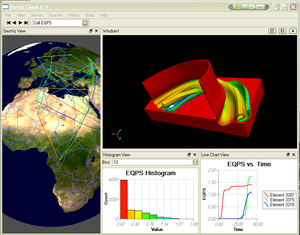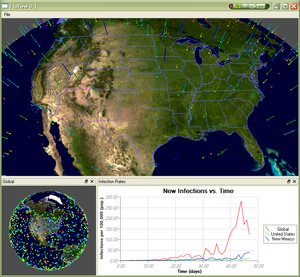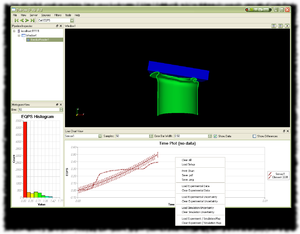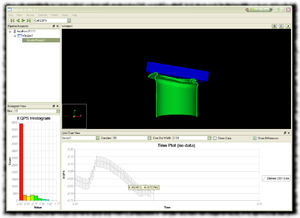ParaQ Applications
Overview
Following are a collection of screenshots, issues, and ideas raised in conjunction with a set of prototype "applications" built on the ParaQ framework. The goal is to explore what it means to build an application using ParaQ - does an application merely link with the ParaQ libraries, or is there some deeper level of integration? Is an application a separate executable, a dynamically-loaded plugin that reconfigures the user interface, or something else?
Prototypes
GeoViz Component
|
"GeoViz", a set of VTK-derived classes created at Sandia, linked into a "vanilla" pqClient as a "component". There is a low level of integration in this example, since the GeoViz component encapsulates a separate, client-side-only pipeline that is independent of the ParaView Server layer. The next step is to get the GeoViz classes accepted into VTK so that the GeoViz view can be implemented in PVS, possibly as a compound filter. This suggests that the GeoViz "component" may ultimately be some combination of a factory method that adds a subgraph to the PVS, plus a user-interface component (i.e. a custom property sheet) that is designed to interact with the subgraph. |
FluView
|
A more realistic sample application using the GeoViz component (the data was randomly-generated). As before, the current iteration of the GeoViz component is unrealistically simple, since it is made of client-side VTK classes. This example does highlight the need for coordination between components - the intent is to tie the two GeoViz views together using some sort of linking or custom interactors. There is also an interesting performance issue, the app takes a long time to load, since there are two instances of the GeoViz component (and thus two instances of the 27 megabyte "blue marble" texture) to be loaded. These two instances should share the same input texture, which will have an impact on their ultimate incarnations as PVS graphs. The GeoViz component could leave-out the input reader altogether, and expose an API to allow it to be connected, or the factory function might be made more complex, allowing a "default" reader to be overridden externally. |
Dobran-O-Viz
|
See the Dobran-O-Viz Documentation for details. Sample application that builds on "vanilla" ParaQ by replacing the existing line chart with a custom line chart class that displays two datasets simultaneously - one extracted from an Exodus reader, and one imported from CSV files. The line chart also demonstrates a custom line plot derivative that can display a popup "image tip" when the pointer is hovered over it. The bulk of the code in this example is the main window class, which is a cut-n-paste copy of pqMainWindow. This was necessary in order to instantiate the custom line chart. A useful next step would be to improve pqMainWindow so that there is less duplication of effort, and more flexibility to create alternate layouts. |
|
|
Dobran-O-Viz 0.2 applies several lessons-learned to customization and re-use of context menus (unshown), and includes displays of data uncertainty. |



